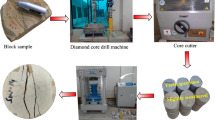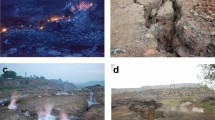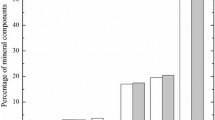Abstract
The purpose of the present study is to investigate the variations in fracture evolution of sandstones arising from mineralogical and textural features. For this purpose, eight types of coal measure sandstones located in the Zonguldak Hardcoal Basin (ZHB) were considered. The mineralogical and textural characterizations of the rocks were carried out. Physico-mechanical properties were determined for each rock type. Based on quantitative strain-based methods, the crack initiation (σci) and crack damage (σcd) thresholds of the sandstones were determined. The laboratory test results indicate that the σci and σcd of the sandstones were found to be between 0.27–0.43 and 0.61–0.83 of the UCS, respectively. In general, the σci and σcd correspond to 0.37 and 0.71 of the UCS, respectively. The σci and σcd decrease with increasing the sorting coefficient (Sc), average grain size (d50, mm), contents of feldspar (F, %), and lithic fragment (LF, %). On the other hand, increasing quartz content (Qtz, %) increases those variables. Remarkable changes were obtained in the σci and σcd when effective porosity (ne) and pulse wave velocity (Vp) of the rocks exceed 3% and 3.00 km/s, respectively. As a result of mineralogical analyses and laboratory studies, statistical analyses were carried out. Accordingly, the σci and σcd could be estimated reliably using several empirical relationships established in the present study. In order to represent the importance and utilization of rock mineralogy and texture for underground mining applications in the ZHB, several suggestions and considerations related to a V-cut gallery blasting operation were introduced.
Similar content being viewed by others
References
Lajtai EZ (1974) Brittle fracture in compression. Int J Fract Mech 10:525–536. https://doi.org/10.1007/BF00155255
Eberhardt E, Stead D, Stimpson B, Read R (1998) Identifying crack initiation and propagation thresholds in brittle rocks. Can Geotech J 35(2):222–233. https://doi.org/10.1139/t97-091
Cai M, Kaiser PK, Tasaka Y, Maejima T, Morioka H, Minami M (2004) Generalized crack initiation and crack damage stress thresholds of brittle rock masses near underground excavations. Int J Rock Mech Min Sci 41:833–847. https://doi.org/10.1016/j.ijrmms.2004.02.001
Diederichs M, Kaiser P, Eberhardt E (2004) Damage initiation and propagation in hard rock during tunnelling and the influence of near-face stress rotation. Int J Rock Mech Min Sci 41(5):785–812. https://doi.org/10.1016/j.ijrmms.2004.02.003
Andersson JC, Martin CD, Stille H (2009) The Äspö Pillar stability experiment: part II—rock mass response to coupled excavation-induced and thermal-induced stresses. Int J Rock Mech Min Sci 46:879–895. https://doi.org/10.1016/j.ijrmms.2009.03.002
Perras MA, Diederichs MS (2016) Predicting excavation damage zone depths in brittle rocks. Rock Mech Geotech Eng 8(1):60–74. https://doi.org/10.1016/j.jrmge.2015.11.004
Martin CD, Christiansson R (2009) Estimating the potential for spalling around a deep nuclear waste repository in crystalline rock. Int J Rock Mech Min Sci 46(2):219–228. https://doi.org/10.1016/j.ijrmms.2008.03.001
Damjanac B, Fairhurst C (2010) Evidence for a long-term strength threshold in crystalline rock. Rock Mech Rock Eng 43:513–531. https://doi.org/10.1007/s00603-010-0090-9
Jiang H, Du C, Liu S, Gao K (2014) Numerical simulation of rock fragmentation under the impact load of water jet. Shock Vib. https://doi.org/10.1155/2014/219489
Lu Y, Zuo S, Ge Z, Xiao S, Cheng Y (2016) Experimental study of crack Initiation and extension induced by hydraulic fracturing in a tree-type borehole array. Energies 9(7):514. https://doi.org/10.3390/en9070514
Liu Q, Liu J, Pan Y, Kong X, Hong K (2017) A case study of TBM performance prediction using a Chinese rock mass classification system—hydropower classification (HC) method. Tunnel Underg Space Technol 65:140–154. https://doi.org/10.1016/j.tust.2017.03.002
Niu Y, Zhou XP, Zhang JZ, Qian QH (2019) Experimental study on crack coalescence behavior of double unparallel fissure-contained sandstone specimens subjected to freeze-thaw cycles under uniaxial compression. Cold Reg Sci Technol 158:166–181. https://doi.org/10.1016/j.coldregions.2018.11.015
Brace WF, Paulding B, Scholz C (1966) Dilatancy in the fracture of crystalline rocks. J Geophys Res 71:3939–3953. https://doi.org/10.1029/JZ071i016p03939
Stacey TR (1981) A simple extension strain criterion for fracture of brittle rock. Int J Rock Mech Min Sci Geomech Abstr 18(6):469–474. https://doi.org/10.1016/0148-9062(81)90511-8
Martin CD, Chandler NA (1994) The progressive fracture of Lac du Bonnet granite. Int J Rock Mech Min Sci Geomech Abstr 31(6):643–659. https://doi.org/10.1016/0148-9062(94)90005-1
Diederichs MS (2007) The 2003 Canadian Geotechnical Colloquium: mechanistic interpretation and practical application of damage and spalling prediction criteria for deep tunnelling. Can Geotech J 44(9):1082–1116. https://doi.org/10.1139/T07-033
Nicksiar M, Martin CD (2012) Evaluation of methods for determining crack initiation in compression tests on low-porosity rocks. Rock Mech Rock Eng 45:607–617. https://doi.org/10.1007/s00603-012-0221-6
Pengfei L, Jianzhao H, Qingchi C (2014) A volumetric strain-based method to determined crack initiation stress of low-porosity rocks. In: 5th international conference on intelligent systems design and engineering applications 2014, pp 106–108. https://doi.org/10.1109/ISDEA.2014.31
Wen T, Tang H, Ma J, Wang Y (2018) Evaluation of methods for determining crack initiation stress under compression. Eng Geol 235:81–97. https://doi.org/10.1016/j.enggeo.2018.01.018
Zhao XG, Cai M, Wang J, Li PF, Ma LK (2015) Objective determination of crack initiation stress of brittle rocks under compression using AE measurement. Rock Mech Rock Eng 48:2473–2484. https://doi.org/10.1007/s00603-014-0703-9
Yang SQ, Tian WL, Huang YH, Ma GZ, Fan LF, Wu ZJ (2018) Experimental and discrete element modeling on cracking behavior of sandstone containing a single oval flaw under uniaxial compression. Eng Fract Mech 194:154–174. https://doi.org/10.1016/j.engfracmech.2018.03.003
Wu H, Zhao G, Liang W (2019) Investigation of cracking behavior and mechanism of sandstone specimens with a hole under compression. Int J Mech Sci 163:105084. https://doi.org/10.1016/j.ijmecsci.2019.105084
Lou Y, Zhang G, Wang X (2019) Cracking mode analysis of crack initiation in rocks under uniaxial compression. Adv Civ Eng. https://doi.org/10.1155/2019/5818071
Erişiş S, Tuğrul A, Yılmaz Ö, Er S (2019) Investigation of the effects of mineralogic and petrographical characteristics of basaltic rocks on acoustic emission. J Geol Eng 43:1–22. https://doi.org/10.24232/jmd.572450
Nicksiar M, Martin CD (2013) Crack initiation stress in low porosity crystalline and sedimentary rocks. Eng Geol 154:64–76. https://doi.org/10.1016/j.enggeo.2012.12.007
Zhao XG, Cai M, Wang J, Ma LK (2013) Damage stress and acoustic emission characteristics of the Beishan granite. Int J Rock Mech Min Sci 64:258–269. https://doi.org/10.1016/j.ijrmms.2013.09.003
Basu A, Mishra DA (2014) A method for estimating crack initiation stress of rock materials by porosity. J Geol Soc India 84:397–405. https://doi.org/10.1007/s12594-014-0145-8
Kim JS, Lee KS, Cho WJ, Choi HJ, Cho GC (2015) A comparative evaluation of stress–strain and acoustic emission methods for quantitative damage assessments of brittle rock. Rock Mech Rock Eng 48:495–508. https://doi.org/10.1007/s00603-014-0590-0
Ündül Ö, Amann F, Aysal N, Plötze M (2015) Micro-textural effects on crack initiation and crack propagation of andesitic rocks. Eng Geol 193:267–275. https://doi.org/10.1016/j.enggeo.2015.04.024
Ündül Ö, Aysal N, Çobanoğlı BC, Amann F, Perras M (2016) Strength, deformation and cracking characteristics of limestones. In: Ulusay R et al (eds) Rock mechanics and rock engineering: from the past to the future, Nevşehir, Turkey, pp 181–185
Köken E (2019) On the variation in several rock properties due to magnesium sulfate weathering tests—a case study for limestones. In: 19th ınternational multidisciplinary scientific geoconference (SGEM 2019), vol 1–2, pp 405–412. https://doi.org/10.5593/sgem2019/1.2/S02.052
Nicksiar M, Martin CD (2014) Factors affecting crack initiation in low porosity crystalline rocks. Rock Mech Rock Eng 47:1165–1181. https://doi.org/10.1007/s00603-013-0451-2
Hatzor YH, Palchik V (1997) The influence of grain size and porosity on crack initiation stress and critical flaw length in dolomites. Int J Rock Mech Min Sci 34(5):805–816. https://doi.org/10.1016/S1365-1609(96)00066-6
Eberhardt E, Stimpson B, Stead D (1999) Effects of grain size on the initiation and propagation thresholds of stress-induced brittle fractures. Rock Mech Rock Eng 32:81–99. https://doi.org/10.1007/s006030050026
Backers T, Stephansson O (2012) ISRM suggested method for the determination of Mode II fracture toughness. Rock Mech Rock Eng 45:1011–1022. https://doi.org/10.1007/s00603-012-0271-9
Haeri H, Shahriar K, Marji MF, Moarefvand P (2014) On the strength and crack propagation process of the pre-cracked rock-like specimens under uniaxial compression. Strength Mater 46(1):140–152. https://doi.org/10.1007/s11223-014-9525-y
Bartmann K, Alber M (2017) Experimental determination of crack Initiation and crack damage of two granites. Proc Eng 191:119–126. https://doi.org/10.1016/j.proeng.2017.05.162
Kong R, Feng XT, Zhang X, Yang C (2018) Study on crack initiation and damage stress in sandstone under true triaxial compression. Int J Rock Mech Min Sci 106:117–123. https://doi.org/10.1016/j.ijrmms.2018.04.019
Ning J, Wang J, Jiang J, Hu S, Jiang L, Liu X (2018) Estimation of crack initiation and propagation thresholds of confined brittle coal specimens based on energy dissipation theory. Rock Mech Rock Eng 51:119–134. https://doi.org/10.1007/s00603-017-1317-9
ISRM (2007) The complete ISRM suggested methods for rock characterization, testing and monitoring: 1974–2006. In: Ulusay R, Hudson JA (eds) Suggested methods prepared by the commission on testing methods. 2007 International Society for Rock Mechanics (ISRM), Ankara, Turkey
Pengfei L, Qingchi C (2014) Analysis of the approaches to determine crack initiation stress of rock materials in compression tests. Appl Mech Mater 556–562:2857–2861. https://doi.org/10.4028/www.scientific.net/AMM.556-562.2857
Folk RL (1981) Petrology of sedimentary rocks, Hemphill Pub., Austin. ISBN: 0-914696-14-9
Folk RL, Ward WC (1957) Brazos River bar, a study in the significance of grain size parameters. J Sediment Petrol 27(1):3–26. https://doi.org/10.1306/74D70646-2B21-11D7-8648000102C1865D
Wong RHC, Chau KT, Wang P (1996) Microcracking and grain size effect in Yuen Long Marbles. Int J Rock Mech Min Sci Geomech Abstr 33(5):479–485. https://doi.org/10.1016/0148-9062(96)00007-1
Tugrul A, Zarif IH (1999) Correlation of mineralogical and textural characteristics with engineering properties of selected granitic rocks from Turkey. Eng Geol 51:303–317. https://doi.org/10.1016/S0013-7952(98)00071-4
Přikryl R (2001) Some microstructural aspects of strength variation in rocks. Int J Rock Mech Min Sci 38(5):671–682. https://doi.org/10.1016/S1365-1609(01)00031-4
Bieniawski ZT (1989) Engineering rock mass classifications: a complete manual for engineers and geologists in mining, civil and petroleum engineering. Wiley-Interscience, New York
Barton N (1988) Rock mass classification and tunnel reinforcement selection using the Q system. In: Kirkaldie L (ed) Rock classification systems for engineering purposes, ASTM STP 984. American Society for Testing Materials, pp 69–88. https://doi.org/10.1520/STP984-EB
Gerçek H (1986) Stability considerations for underground excavation intersections. Min Sci Technol 4(1):49–57. https://doi.org/10.1016/S0167-9031(86)90194-5
Acknowledgements
The author is greatly indebted to staff members; Birol KARAÇAM and Dinçer ACUN (Mining engineers), Mehmet KUZU and Miraç KOCA (Topographers), Turan ZARARCI, Aydın EKİNCİ, Erhan KEÇELİOĞLU and Şendoğan ÖZAT (Mining technicians) of Turkish Hard Coal Enterprise Institution (TTK, Zonguldak—Turkey) for their invaluable help at obtaining rock blocks and sharing experiences during underground field observations. The author also appreciates the constructive comments and suggestions of the editor and anonymous reviewers.
Author information
Authors and Affiliations
Corresponding author
Additional information
Publisher's Note
Springer Nature remains neutral with regard to jurisdictional claims in published maps and institutional affiliations.
Rights and permissions
About this article
Cite this article
Köken, E. Investigations on Fracture Evolution of Coal Measure Sandstones from Mineralogical and Textural Points of View. Indian Geotech J 50, 1024–1040 (2020). https://doi.org/10.1007/s40098-020-00427-1
Received:
Accepted:
Published:
Issue Date:
DOI: https://doi.org/10.1007/s40098-020-00427-1













